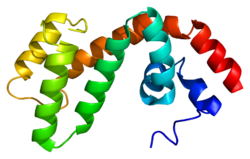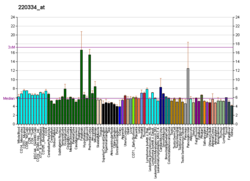RGS17
RGS17
Protein-coding gene in the species Homo sapiens
Regulator of G-protein signaling 17 is a protein that in humans is encoded by the RGS17 gene.[5][6]
| RGS17 | |||||||||||||||||||||||||||||||||||||||||||||||||||
|---|---|---|---|---|---|---|---|---|---|---|---|---|---|---|---|---|---|---|---|---|---|---|---|---|---|---|---|---|---|---|---|---|---|---|---|---|---|---|---|---|---|---|---|---|---|---|---|---|---|---|---|
 | |||||||||||||||||||||||||||||||||||||||||||||||||||
| |||||||||||||||||||||||||||||||||||||||||||||||||||
| Identifiers | |||||||||||||||||||||||||||||||||||||||||||||||||||
| Aliases | RGS17, RGS-17, RGSZ2, hregulator of G-protein signaling 17, regulator of G protein signaling 17 | ||||||||||||||||||||||||||||||||||||||||||||||||||
| External IDs | OMIM: 607191 MGI: 1927469 HomoloGene: 8242 GeneCards: RGS17 | ||||||||||||||||||||||||||||||||||||||||||||||||||
| |||||||||||||||||||||||||||||||||||||||||||||||||||
| |||||||||||||||||||||||||||||||||||||||||||||||||||
| |||||||||||||||||||||||||||||||||||||||||||||||||||
| |||||||||||||||||||||||||||||||||||||||||||||||||||
| |||||||||||||||||||||||||||||||||||||||||||||||||||
| Wikidata | |||||||||||||||||||||||||||||||||||||||||||||||||||
| |||||||||||||||||||||||||||||||||||||||||||||||||||
This gene encodes a member of the regulator of G-protein signaling family. This protein contains a conserved, 120 amino acid motif called the RGS domain and a cysteine-rich region. The protein attenuates the signaling activity of G-proteins by binding to activated, GTP-bound G alpha subunits and acting as a GTPase activating protein (GAP), increasing the rate of conversion of the GTP to GDP. This hydrolysis allows the G alpha subunits to bind G beta/gamma subunit heterodimers, forming inactive G-protein heterotrimers, thereby terminating the signal.[6] Along with RGS4, RGS9 and RGS14,[7][8] RGS17 plays an important role in termination of signalling by mu opioid receptors and development of tolerance to opioid analgesic drugs.[9][10]
RGS17 is a putative lung cancer susceptibility gene in the lung cancer associated locus on chromosome 6q in humans.[11] RGS17 is overexpressed in lung and prostate cancers, induces cAMP production, CREB phosphorylation and CREB responsive gene expression[2]. Expression of RGS17 is required for maintenance of proliferation in lung tumor cell lines.[12]
- "Human PubMed Reference:". National Center for Biotechnology Information, U.S. National Library of Medicine.
- "Mouse PubMed Reference:". National Center for Biotechnology Information, U.S. National Library of Medicine.
- Jordan JD, Carey KD, Stork PJ, Iyengar R (Jul 1999). "Modulation of rap activity by direct interaction of Galpha(o) with Rap1 GTPase-activating protein". The Journal of Biological Chemistry. 274 (31): 21507–10. doi:10.1074/jbc.274.31.21507. PMID 10419452.
- Garzón J, Rodríguez-Muñoz M, de la Torre-Madrid E, Sánchez-Blázquez P (Jun 2005). "Effector antagonism by the regulators of G protein signalling (RGS) proteins causes desensitization of mu-opioid receptors in the CNS". Psychopharmacology. 180 (1): 1–11. doi:10.1007/s00213-005-2248-9. hdl:10261/154655. PMID 15830230. S2CID 21952312.
- Rodríguez-Muñoz M, de la Torre-Madrid E, Gaitán G, Sánchez-Blázquez P, Garzón J (Dec 2007). "RGS14 prevents morphine from internalizing Mu-opioid receptors in periaqueductal gray neurons". Cellular Signalling. 19 (12): 2558–71. doi:10.1016/j.cellsig.2007.08.003. PMID 17825524.
- Garzón J, Rodríguez-Muñoz M, López-Fando A, Sánchez-Blázquez P (Sep 2005). "The RGSZ2 protein exists in a complex with mu-opioid receptors and regulates the desensitizing capacity of Gz proteins". Neuropsychopharmacology. 30 (9): 1632–48. doi:10.1038/sj.npp.1300726. PMID 15827571.
- Rodríguez-Muñoz M, de la Torre-Madrid E, Sánchez-Blázquez P, Garzón J (2007). "Morphine induces endocytosis of neuronal mu-opioid receptors through the sustained transfer of Galpha subunits to RGSZ2 proteins". Molecular Pain. 3: 1744-8069–3-19. doi:10.1186/1744-8069-3-19. PMC 1947952. PMID 17634133.
- You M, Wang D, Liu P, Vikis H, James M, Lu Y, Wang Y, Wang M, Chen Q, Jia D, Liu Y, Wen W, Yang P, Sun Z, Pinney SM, Zheng W, Shu XO, Long J, Gao YT, Xiang YB, Chow WH, Rothman N, Petersen GM, de Andrade M, Wu Y, Cunningham JM, Wiest JS, Fain PR, Schwartz AG, Girard L, Gazdar A, Gaba C, Rothschild H, Mandal D, Coons T, Lee J, Kupert E, Seminara D, Minna J, Bailey-Wilson JE, Amos CI, Anderson MW (Apr 2009). "Fine mapping of chromosome 6q23-25 region in familial lung cancer families reveals RGS17 as a likely candidate gene". Clinical Cancer Research. 15 (8): 2666–74. doi:10.1158/1078-0432.ccr-08-2335. PMC 2746091. PMID 19351763.
- James MA, Lu Y, Liu Y, Vikis HG, You M (Mar 2009). "RGS17, an overexpressed gene in human lung and prostate cancer, induces tumor cell proliferation through the cyclic AMP-PKA-CREB pathway". Cancer Research. 69 (5): 2108–16. doi:10.1158/0008-5472.can-08-3495. PMC 2746047. PMID 19244110.
- Mao H, Zhao Q, Daigle M, Ghahremani MH, Chidiac P, Albert PR (Jun 2004). "RGS17/RGSZ2, a novel regulator of Gi/o, Gz, and Gq signaling". The Journal of Biological Chemistry. 279 (25): 26314–22. doi:10.1074/jbc.M401800200. PMID 15096504.
- Larminie C, Murdock P, Walhin JP, Duckworth M, Blumer KJ, Scheideler MA, Garnier M (Mar 2004). "Selective expression of regulators of G-protein signaling (RGS) in the human central nervous system". Brain Research. Molecular Brain Research. 122 (1): 24–34. doi:10.1016/j.molbrainres.2003.11.014. PMID 14992813.
- Fischer T, De Vries L, Meerloo T, Farquhar MG (Jul 2003). "Promotion of G alpha i3 subunit down-regulation by GIPN, a putative E3 ubiquitin ligase that interacts with RGS-GAIP". Proceedings of the National Academy of Sciences of the United States of America. 100 (14): 8270–5. Bibcode:2003PNAS..100.8270F. doi:10.1073/pnas.1432965100. PMC 166218. PMID 12826607.
- Sierra DA, Gilbert DJ, Householder D, Grishin NV, Yu K, Ukidwe P, Barker SA, He W, Wensel TG, Otero G, Brown G, Copeland NG, Jenkins NA, Wilkie TM (Feb 2002). "Evolution of the regulators of G-protein signaling multigene family in mouse and human". Genomics. 79 (2): 177–85. doi:10.1006/geno.2002.6693. PMID 11829488. S2CID 16065132.
This article on a gene on human chromosome 6 is a stub. You can help Wikipedia by expanding it. |




